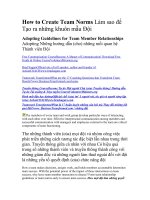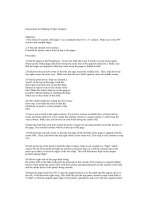Energize your workplace how to create and sustain high quality connections at work
Bạn đang xem bản rút gọn của tài liệu. Xem và tải ngay bản đầy đủ của tài liệu tại đây (944.48 KB, 224 trang )
innovative solutions to the
pressing problems of business
The mission of the University of Michigan Business School Management Series is to provide
accessible, practical, and cutting-edge solutions
to the most critical challenges facing businesspeople today. The UMBS Management Series
provides concepts and tools for people who
seek to make a significant difference in their organizations. Drawing on the research and experience of faculty at the University of Michigan
Business School, the books are written to stretch
thinking while providing practical, focused, and
innovative solutions to the pressing problems of
business.
Also available in the UMBS series:
Becoming a Better Value Creator, by Anjan V. Thakor
Achieving Success Through Social Capital, by Wayne Baker
Improving Customer Satisfaction, Loyalty, and Profit,
by Michael D. Johnson and Anders Gustafsson
The Compensation Solution, by John E. Tropman
Strategic Interviewing, by Richaurd Camp, Mary Vielhaber,
and Jack L. Simonetti
Creating the Multicultural Organization, by Taylor Cox
Getting Results, by Clinton O. Longenecker and
Jack L. Simonetti
A Company of Leaders, by Gretchen M. Spreitzer and
Robert E. Quinn
Managing the Unexpected, by Karl Weick and Kathleen Sutcliffe
Using the Law for Competitive Advantage, by George J. Siedel
Creativity at Work, by Jeff DeGraff and Katherine A. Lawrence
Making I/T Work, by Dennis G. Severance and Jacque Passino
Decision Management, by J. Frank Yates
A Manager’s Guide to Employment Law, by Dana M. Muir
The Ethical Challenge, edited by Noel M. Tichy and
Andrew R. McGill
Competing in a Service Economy, by Anders Gustafsson and
Michael D. Johnson
For additional information on any of these titles or future
titles in the series, visit www.umbsbooks.com.
Executive Summary
nergy—the sense of being eager to act and capable of
action—is a critical, limited, but renewable resource that
enables excellence in individuals and organizations. Without effective means for generating and replenishing the energy
of individuals in the workplace, no organization can ever be
truly great.
Managers and leaders can make a profound difference in activating and renewing energy by building and sustaining highquality connections with coworkers, bosses, subordinates,
customers—anyone with whom they have contact at work. Highquality connections are marked by mutual positive regard, trust,
and active engagement. They are connections in which people
literally feel more alive and vibrant. They can be created in an
instant—in a conversation, an e-mail exchange, or a meeting—
and their effects can be powerful and long-lasting. High-quality
connections contribute substantially to individuals’ well-being
and work performance. They also contribute significantly to an
organization’s capacity for collaboration, coordination, learning,
and adaptation, as well as its ability to keep people committed
and loyal.
Managers and leaders shape possibilities for energy in
connection through two important means: how they interact
E
with others and how they design and construct the contexts in
which others interact. This book guides managers through both
possibilities and offers concrete action suggestions for building
these vitalizing connections.
Chapter One introduces the idea of connection quality and
documents the far-reaching consequences of high- and lowquality connections for both individuals and organizations. The
next three chapters each describe a pathway to building highquality connections. Chapter Two focuses on respectful engagement and identifies a range of strategies for interacting in ways
that convey messages of value and worth. Chapter Three focuses
on task enabling as a potent set of strategies for taking actions
that help another person to succeed and perform effectively.
Chapter Four focuses on trust and details how managers build
trust both by what they say and do and by what they refrain
from saying and doing.
Management of connection quality also involves dealing
constructively with low-quality connections that corrode individuals’ sense of worth, competence, and value. These corrosive
connections are all too prevalent in work organizations, and they
leave major damage in their wake both for individuals and for
the organization as a whole. Chapter Five identifies a range of
strategies for reducing the damage of corrosive connections, and
in some cases, transforming them into energy-producing as opposed to energy-depleting connections.
Chapter Six tackles the creation and design of contexts in
which high-quality connections flourish. It examines key features of organizational context that influence the quality of connections, from organizational values to the design of physical
space. The examination of these features reveals strategies managers and leaders can deploy to improve the climate for highquality connections in their work group, department, unit, or
organization.
Although this book is based squarely on research, it is written to be a practical guide. Each chapter provides abundant examples, detailed descriptions of actions to take, and assessments
and other tools to help readers evaluate the quality of the connections in their workplace and take immediate steps to vitalize
their work environment through the transformative power of
high-quality connections.
Energize Your
Workplace
How to Create and Sustain
High-Quality Connections
at Work
Jane E. Dutton
Copyright © 2003 by John Wiley & Sons, Inc. All rights reserved.
Published by Jossey-Bass
A Wiley Imprint
989 Market Street, San Francisco, CA 94103-1741
www.josseybass.com
No part of this publication may be reproduced, stored in a retrieval system, or transmitted in any form or by any means, electronic, mechanical, photocopying, recording,
scanning, or otherwise, except as permitted under Section 107 or 108 of the 1976
United States Copyright Act, without either the prior written permission of the Publisher, or authorization through payment of the appropriate per-copy fee to the Copyright Clearance Center, Inc., 222 Rosewood Drive, Danvers, MA 01923, 978-750-8400,
fax 978-750-4470, or on the web at www.copyright.com. Requests to the Publisher for
permission should be addressed to the Permissions Department, John Wiley & Sons,
Inc., 111 River Street, Hoboken, NJ 07030, 201-748-6011, fax 201-748-6008, e-mail:
Jossey-Bass books and products are available through most bookstores. To contact
Jossey-Bass directly call our Customer Care Department within the U.S. at 800-9567739, outside the U.S. at 317-572-3986 or fax 317-572-4002.
Jossey-Bass also publishes its books in a variety of electronic formats. Some content
that appears in print may not be available in electronic books.
Library of Congress Cataloging-in-Publication Data
Dutton, Jane E.
Energize your workplace: how to create and sustain high-quality
connections at work/Jane E. Dutton.—1st ed.
p. cm.—(University of Michigan Business School management
series)
Includes bibliographical references and index.
ISBN 0-7879-5622-8 (alk. paper)
1. Reengineering (Management). 2. Communication in organizations.
3. Organizational change. 4. Management. I. Title. II. Series.
HD58.87.D885 2003
658.4'063—dc21
2003010517
Printed in the United States of America
FIRST EDITION
HB Printing 10 9 8 7 6 5 4 3 2 1
Contents
Series Foreword xiii
Preface xv
1
2
3
4
5
6
Creating Energy Through High-Quality
Connections 1
Respectful Engagement 21
Task Enabling 51
Trusting 79
Dealing with Corrosive Connections 109
Building High-Quality Connections
in Your Organization 139
Notes 175
The Author 191
Index 193
xi
To my parents, Kate and George Dutton
Series Foreword
elcome to the University of Michigan Business School
Management Series. The books in this series address
the most urgent problems facing business today. The
series is part of a larger initiative at the University of Michigan
Business School (UMBS) that ties together a range of efforts to
create and share knowledge through conferences, survey research, interactive and distance training, print publications, and
news media.
It is just this type of broad-based initiative that sparked my
love affair with UMBS in 1984. From the day I arrived I was enamored with the quality of the research, the quality of the MBA
program, and the quality of the Executive Education Center.
Here was a business school committed to new lines of research,
new ways of teaching, and the practical application of ideas. It
was a place where innovative thinking could result in tangible
outcomes.
The UMBS Management Series is one very important outcome, and it has an interesting history. It turns out that every
year five thousand participants in our executive program fill out
a marketing survey in which they write statements indicating
W
xiii
xiv
Series Foreword
the most important problems they face. One day Lucy Chin, one
of our administrators, handed me a document containing all
these statements. A content analysis of the data resulted in a list
of forty-five pressing problems. The topics ranged from growing
a company to managing personal stress. The list covered a wide
territory, and I started to see its potential. People in organizations
tend to be driven by a very traditional set of problems, but the
solutions evolve. I went to my friends at Jossey-Bass to discuss
a publishing project. The discussion eventually grew into the
University of Michigan Business School Management Series—
Innovative Solutions to the Pressing Problems of Business.
The books are independent of each other, but collectively
they create a comprehensive set of management tools that cut
across all the functional areas of business—from strategy to
human resources to finance, accounting, and operations. They
draw on the interdisciplinary research of the Michigan faculty.
Yet each book is written so a serious manager can read it quickly
and act immediately. I think you will find that they are books that
will make a significant difference to you and your organization.
Robert E. Quinn, Consulting Editor
M.E. Tracy Distinguished Professor
University of Michigan Business School
Preface
y colleague Bob Quinn often knows things before I do.
He had a strong inkling before I even dreamed of writing a book that I had something to say about energy
and organizations. He challenged me to take what I know about
building high-quality connections in organizations and use it to
crack open a fundamental problem that all businesses face: how
can leaders and managers produce energy and vitality as critical and renewable resources that make organizations and the
people within them great?
This book is the result of this challenge. Abundant research
suggests that a fundamental key to increasing energy in the
workplace, and thereby increasing the effectiveness of both individuals and organizations, is the building of high-quality connections—ties between people marked by mutual regard, trust,
and active engagement. A focus on high-quality connections and
their energy-generating capabilities shows how small actions—
such as respectful engagement with another person—can transform the energy possibilities in both people. It also highlights
the role of managers like you in serving as role models and in
M
xv
xvi
Preface
designing contexts that enable these kinds of energy-generating
connections to flourish.
The book stands on a solid foundation of research, but it is
intended to be practical and useful, applicable to the everyday
choices you make about how you interact with others. It offers
tools for taking stock of your current connecting practices, and it
invites you to consider alternative strategies that will better energize your workplace. It also asks you to consider how key features of the organizational context work to enhance or diminish
the likelihood of high-quality connections. A wealth of examples
illustrate the profound differences you can make in generating
connections that build vitality and energy for yourself and for
those you interact with at work—whether those persons are
bosses, subordinates, customers, suppliers, or coworkers.
■ The Goals of This Book
When I say I am writing a book on energizing your workplace,
people resonate. Very often they have a gut level reaction that
registers, yes, I have experiences at work all the time that affect
my energy and the energy of those around me. However, most
of the stories they tell me are of connections that sap and deplete
energy. I call these kinds of connections corrosive. They are all too
prevalent in the workplace. Stories of organizations that drain
and deaden are far more frequent than stories about organizations that revitalize and enliven. This reality has inspired me to
set four goals for this book.
First, I want managers to seriously consider energy as a
critical, limited, but renewable resource that enables excellence
in individuals and organizations. Without effective means for
generating and replenishing the energy of individuals in the
workplace, no organization can ever be truly great. Further, no
organization can retain the people it really wants to retain and
have them achieve the levels of excellence they desire.
Preface
xvii
Second, I want managers to take their role as energy creators or energy depleters seriously. I also want them to see new
possibilities for enlivening their workplace through building and
enabling high-quality connections. This means having a perspective on how their everyday behaviors and their actions in
designing the organizational context can create and replenish
energy, contributing to all kinds of important outcomes, including employees’ physical and psychological health, task engagement, learning, cooperation, coordination, attachment, and
overall effectiveness.
Third, I want managers to have better and more abundant
strategies for dealing with corrosive connections at work. Although low-quality connections infect most organizations, it’s
rare for anyone to have training or practice in how to deal with
them constructively or coach others to do so.
Fourth, I hope this book convinces managers of the important connection between the quality of the connections they have
at work and their overall well-being. The fact is that most of us
spend a good percentage of our waking hours at our workplaces. In those places, we either are enlivened or deadened
through the quality of the connections that we have with others.
In the short run, these effects show up in performance and other
organizationally relevant outcomes. In the long run, they leave
lasting traces on our bodies and health. My greatest hope is that
the managers who read this book will practice new ways of infusing vitality into the workplace by not only reducing corrosive
connections but also increasing the frequency and vibrancy of
high-quality connections. Their own lives depend on it.
■ Acknowledgments
I thank Bob Quinn for his initial challenge and the opportunity
to meet the challenge through the writing of this book. Bob sees
possibilities that other people do not dare to imagine, and he
xviii
Preface
makes them happen. The UMBS Management Series is the end
product of his vision in partnership with the Jossey-Bass team.
I have benefited greatly from their creative vision and from the
enabling and fine editing from John Bergez. I thank them all for
their wonderful support in making this book happen.
No book is ever done alone. This book, in particular, was
conceived jointly with Robert Holmes at the University of
Michigan, who lives the content of this book on a daily basis. I
benefited greatly from his mentorship and partnership in the initial structuring and writing. I hope he is pleased with the final
product. Other University of Michigan staff members have also
been instrumental in supporting the creation of this book. I
would like to thank Maureen Burns, Mary Ceccanese, Dianne
Haft, Sally Johnson, Paula Kopka, and Cynthia Shaw for their
inspiration and instrumental help.
Many colleagues and both former and current students
were invaluable in the book’s creation. Jean Bartunek, Joyce
Fletcher, Peter Frost, Christine Pearson, and Steve Stumpf read
various drafts and offered wonderful insights and suggestions.
Peter Frost provided significant encouragement through the entire journey of writing this book. Susan Bernstein and Laura
Atlantis are two former MBA students who left lasting positive
imprints on the book’s content and structure. Steve Mondry,
a former undergraduate student also provided useful feedback and examples. My faculty colleagues at the University of
Michigan—Sue Ashford, Wayne Baker, Kim Cameron, Paula
Caproni, Michael Cohen, Martha Feldman, Jane Hassinger,
Maggie Lampert, Kim Leary, Bob Quinn, Gretchen Spreitzer,
Kathie Sutcliffe, Jim Walsh, Karl Weick, Janet Weiss, Mayer
Zald—are treasures who continuously enrich my work. My
more distant colleagues—David Cooperrider, Kenneth Gergen,
Connie Gersick, Jody Hoffer Gittell, Mary Ann Glynn, Karen
Golden-Biddle, Hermi Ibarra, Rosabeth Moss Kanter, Sharon
Lobel, Sally Maitlis, Joshua Margolis, Joanne Martin, Debra
Preface
xix
Meyerson, Leslie Perlow, Anat Rafaeli, Huggy Rao, Brian Uzzi,
Joe White—were also important inspirations. Former and current doctoral students contributed immensely to this book. The
research done with Gelaye Debebe and Amy Wrzesniewski inspired the book’s core thesis. For insightful discussions about
high quality connections that gave me confidence to write from
this perspective, I thank Caroline Bartel, Emily Heaphy, Jason
Kanov, Katherine Lawrence, Jacoba Lilius, Regina O’Neill,
Sandy Piderit, Ryan Quinn, Seung-Yoon Rhee, Laura Morgan
Roberts, Nancy Rothbard, Markus Vodosek, Tim Vogus, Michele
Williams, Monica Worline, and Joana Young. Cheryl Baker,
Claudia Cohen, Anne Dutton Keesor, Alisa Miller, and Amy
Saunders are friends and family who generously helped along
the way. The MBA students in my “Managing Professional
Relationships” class brought these ideas to life.
I also want to express my appreciation to the William
Russell Kelly Chair, which has provided important financial support for me and my work, and to the University of Michigan
Business School, which has proved to be a great learning, teaching, and researching environment.
To my husband, Lloyd (Lance) Sandelands, and to my
daughters, Cara and Emily Sandelands: you three help me to
know fully the meaning and significance of high-quality connections. Thank you for your unwavering support and inspiration during the writing of this book.
May 2003
Ann Arbor, Michigan
Jane E. Dutton
Energize Your
Workplace
1
Creating Energy
Through High-Quality
Connections
his is a book about how leaders and managers in their
everyday behaviors can make an enormous difference in
activating and renewing the energy that people bring to
their work. It is also about how to design and construct organizational contexts that produce energy and vitality as critical and
renewable resources that make organizations (and the people
within them) great.
The premise of this book is deceptively simple: the energy
and vitality of individuals and organizations alike depends on
the quality of the connections among people in the organization,
and between organizational members and people outside the
firm with whom they do business. The key to transforming both
T
1









